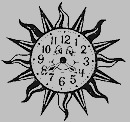
More Light on Jet Lag
Some years and jobs ago, I was given a dream assignment: Make all arrangements for a meeting--in Europe. I went happily to Europe, but then unhappily struggled to stay alert during planning sessions, to make simple decisions, even to stay awake at all. My inner clock had sent my brain to bed, ignoring European real time in favor of remembered Alaska time. I was jet lagged.
Our inner clocks aren't perfect. Take away all external guides--sunlight, clocks, radios, whatever---and people will fall into a 25-hour cycle. We need clues to stay in synch with the sun.
Studies of the effects of one of those clues---light---may help long distance travelers, shift workers, and people with circadian system malfunctions. Working with the victim of such a malady gave Massachusetts sleep researcher Charles Czeisler evidence of an apparently effective way of dealing with jet lag.
Czeisler knew that human internal clocks are light sensitive; he'd conducted an experiment establishing that ordinary room lighting could help synchronize people's circadian patterns to a 24-hour day. Eventually, he wondered if he could reset the inner clocks of people with chronic circadian disorders. He took on a patient willing to be an experimental subject, a woman whose inner clock stubbornly kept more than six hours away from time as the rest of the world measured it. To confront this major circadian problem, Czeisler tried major doses of light---four hours daily of bright light (7000 to 12,000 lux, about equivalent to twilight brightness outdoors and better than three times the intensity of typical room lighting.)
Because earlier studies had indicated that light exposure resets mammalian clocks by an hour or two each day, Czeilser thought the treatment might readjust his subject's clock to near normal in a week or so. Instead, her clock was almost realigned to local time within two days.
Then Czeisler called in a colleague to expand the work. Extrapolating from what had been found in the successful clock-resetting experiment, mathematician Richard Kornauer produced a theoretical model of how light affects the human circadian clock. Czeisler tested the model in a series of experiments, putting volunteers through three days of five-hour exposures to bright light. All subjects received identical treatments, except for the timing of light exposures relative to their circadian cycles.
By varying the time of day when the volunteers received the light treatment, Czeisler, Kornauer, and their co-worders were able to devise a graphic indication --- a phase response curve --- of how light-exposure timing affects the human circadian clock. The most dramatic effect was in subjects who received the light treatment during subjective nighttime; their internal clocks were reset by up to 12 hours.
Czeisler believes the three-day period is also important. The first daily pulse of light reduces the magnitude of circadian cycles --- Czeisler's subjects showed smaller than normal changes in body temperature throughout the day after the first treatment, for example. The second daily dose squelches the cycle and its attendant bodily changes even more. The third day's exposure resets the circadian clock to the new time.
The phase response curve needs more testing and refining before we can expect prescriptions such as, "Flying to Australia? Take 10,000 lux for two hours starting at 5:13 p.m." But Czeilser and Kronauer think they have useful advice for travelers: to avoid jet lag, give yourself an extra weekend at your destination before you must start work---and spend that weekend at the beach. After all, you want long exposure to bright light. Tell your boss it's the doctor's advice.





